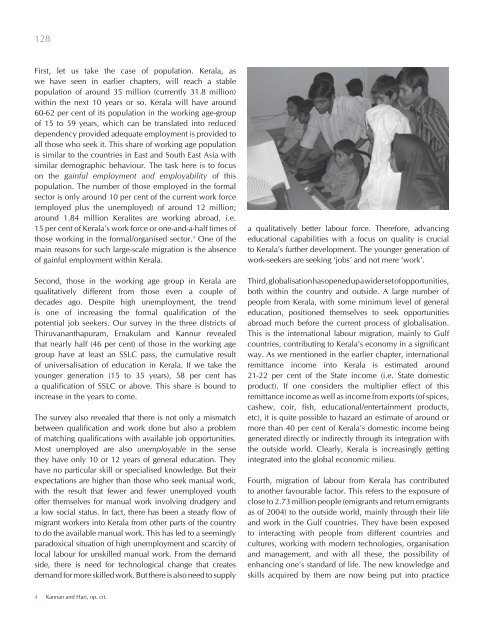Kerala 2005 - of Planning Commission
Kerala 2005 - of Planning Commission
Kerala 2005 - of Planning Commission
Create successful ePaper yourself
Turn your PDF publications into a flip-book with our unique Google optimized e-Paper software.
128<br />
First, let us take the case <strong>of</strong> population. <strong>Kerala</strong>, as<br />
we have seen in earlier chapters, will reach a stable<br />
population <strong>of</strong> around 35 million (currently 31.8 million)<br />
within the next 10 years or so. <strong>Kerala</strong> will have around<br />
60-62 per cent <strong>of</strong> its population in the working age-group<br />
<strong>of</strong> 15 to 59 years, which can be translated into reduced<br />
dependency provided adequate employment is provided to<br />
all those who seek it. This share <strong>of</strong> working age population<br />
is similar to the countries in East and South East Asia with<br />
similar demographic behaviour. The task here is to focus<br />
on the gainful employment and employability <strong>of</strong> this<br />
population. The number <strong>of</strong> those employed in the formal<br />
sector is only around 10 per cent <strong>of</strong> the current work force<br />
(employed plus the unemployed) <strong>of</strong> around 12 million;<br />
around 1.84 million Keralites are working abroad, i.e.<br />
15 per cent <strong>of</strong> <strong>Kerala</strong>’s work force or one-and-a-half times <strong>of</strong><br />
those working in the formal/organised sector. 4 One <strong>of</strong> the<br />
main reasons for such large-scale migration is the absence<br />
<strong>of</strong> gainful employment within <strong>Kerala</strong>.<br />
Second, those in the working age group in <strong>Kerala</strong> are<br />
qualitatively different from those even a couple <strong>of</strong><br />
decades ago. Despite high unemployment, the trend<br />
is one <strong>of</strong> increasing the formal qualification <strong>of</strong> the<br />
potential job seekers. Our survey in the three districts <strong>of</strong><br />
Thiruvananthapuram, Ernakulam and Kannur revealed<br />
that nearly half (46 per cent) <strong>of</strong> those in the working age<br />
group have at least an SSLC pass, the cumulative result<br />
<strong>of</strong> universalisation <strong>of</strong> education in <strong>Kerala</strong>. If we take the<br />
younger generation (15 to 35 years), 58 per cent has<br />
a qualification <strong>of</strong> SSLC or above. This share is bound to<br />
increase in the years to come.<br />
The survey also revealed that there is not only a mismatch<br />
between qualification and work done but also a problem<br />
<strong>of</strong> matching qualifications with available job opportunities.<br />
Most unemployed are also unemployable in the sense<br />
they have only 10 or 12 years <strong>of</strong> general education. They<br />
have no particular skill or specialised knowledge. But their<br />
expectations are higher than those who seek manual work,<br />
with the result that fewer and fewer unemployed youth<br />
<strong>of</strong>fer themselves for manual work involving drudgery and<br />
a low social status. In fact, there has been a steady flow <strong>of</strong><br />
migrant workers into <strong>Kerala</strong> from other parts <strong>of</strong> the country<br />
to do the available manual work. This has led to a seemingly<br />
paradoxical situation <strong>of</strong> high unemployment and scarcity <strong>of</strong><br />
local labour for unskilled manual work. From the demand<br />
side, there is need for technological change that creates<br />
demand for more skilled work. But there is also need to supply<br />
a qualitatively better labour force. Therefore, advancing<br />
educational capabilities with a focus on quality is crucial<br />
to <strong>Kerala</strong>’s further development. The younger generation <strong>of</strong><br />
work-seekers are seeking ‘jobs’ and not mere ‘work’.<br />
Third, globalisation has opened up a wider set <strong>of</strong> opportunities,<br />
both within the country and outside. A large number <strong>of</strong><br />
people from <strong>Kerala</strong>, with some minimum level <strong>of</strong> general<br />
education, positioned themselves to seek opportunities<br />
abroad much before the current process <strong>of</strong> globalisation.<br />
This is the international labour migration, mainly to Gulf<br />
countries, contributing to <strong>Kerala</strong>’s economy in a significant<br />
way. As we mentioned in the earlier chapter, international<br />
remittance income into <strong>Kerala</strong> is estimated around<br />
21-22 per cent <strong>of</strong> the State income (i.e. State domestic<br />
product). If one considers the multiplier effect <strong>of</strong> this<br />
remittance income as well as income from exports (<strong>of</strong> spices,<br />
cashew, coir, fish, educational/entertainment products,<br />
etc), it is quite possible to hazard an estimate <strong>of</strong> around or<br />
more than 40 per cent <strong>of</strong> <strong>Kerala</strong>’s domestic income being<br />
generated directly or indirectly through its integration with<br />
the outside world. Clearly, <strong>Kerala</strong> is increasingly getting<br />
integrated into the global economic milieu.<br />
Fourth, migration <strong>of</strong> labour from <strong>Kerala</strong> has contributed<br />
to another favourable factor. This refers to the exposure <strong>of</strong><br />
close to 2.73 million people (emigrants and return emigrants<br />
as <strong>of</strong> 2004) to the outside world, mainly through their life<br />
and work in the Gulf countries. They have been exposed<br />
to interacting with people from different countries and<br />
cultures, working with modern technologies, organisation<br />
and management, and with all these, the possibility <strong>of</strong><br />
enhancing one’s standard <strong>of</strong> life. The new knowledge and<br />
skills acquired by them are now being put into practice<br />
4 Kannan and Hari, op. cit.

















